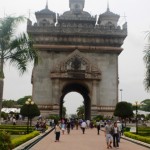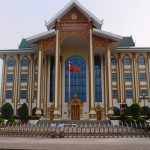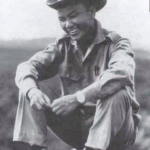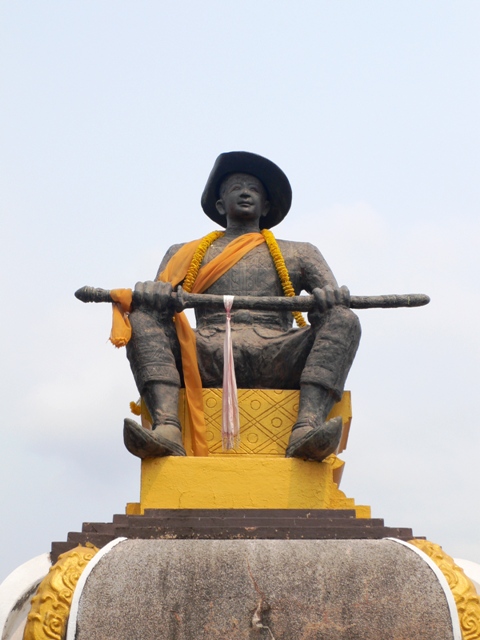Secret Wars Have No Heroes
More on what Obama revealed and rued
A king at rest
(C)text and photos by LARRY CALLOWAY
Air America was created in 1959 to support covert operations in Laos, a landlocked country of no more than 3 million people then, caught between Vietnam and Thailand. Our man in Laos was Phoumi Nosavan, a diminutive general of the Royal Lao Army who became prime minister in a CIA-backed coup in December 1959, two months after death ended the 55-year reign of beloved King Sisavang. Phoumi was a close friend of Field Marshal Sarit Thanarat, his cousin and mentor, who ruled Thailand under martial law with the apparent consent of King Bhumibol. Sarit was ruthless and corrupt. But he had American friends like the Dulles brothers (Secretary of State John Foster and CIA director Allen).
Our backup in the war against communism was Vang Pao, a leader among Hmong hill tribesmen. The hostility between the communists of Laos and the Hmong minority was not only due to the Marxist enmity toward traditional cultures (and religion). The Hmongs, long ago driven out of China, had been on the side of the French in the anti-colonial revolution. American intelligence agents who remained in Thailand after the defeat of Japan helped organize the Hmong and other ethnic minorities in an alliance with the Royal Lao Army against the Pathet Lao, counterpart of the Viet Cong. John Foster Dulles called Laos a “bastion of the free world.”
During the 1960 American election campaign (Kennedy vs. Nixon) a former Royal Lao officer named Kong Le, who now sympathized with the Pathet Lao, occupied Vientiane. What alarmed the Dulles brothers was evidence that he was getting support from the Soviet Union. On inauguration day, President Dwight D. Eisenhower told Kennedy he faced war in Laos. Both men must have known the risk at hand because, unlike the nuclear sword rattlers, they knew war and were informed about Indochina. Early in his administration Eisenhower had authorized disguised American transport planes to supply the French army in its last stand at Dien Ben Phu in North Vietnam, and Kennedy had visited Indochina twice as a congressman before the defeat of the French in 1954.
Laos was far from the minds of most Americans, then as now, and so when the new president addressed the nation two months after his inauguration, he used maps showing the landlocked kingdom’s long border with Vietnam to illustrate his thesis that, in his words, “The security of all Southeast Asia will be endangered if Laos loses its neutral independence.” (He mispronounced Laos, perhaps intentionally.) In June 1961 in Vienna Kennedy and Soviet leader Nikita Khrushchev declared Laos neutral, a sentiment that was signed and sealed in Geneva a year later.
So in May of 1963, as I stepped from a Pan Am Boeing 707 into the tropical heat of Bangkok, the American setup against North Vietnam in Indochina was this: two Buddhist kingdoms run by cousins, (Thailand and Laos) a Buddhist kingdom run by a neutral prince (Sihanouk in Cambodia), and an anti-Buddhist Catholic autocracy run by brothers (Diem and Nhu in South Vietnam). But it was a fragile setup, a row of dominoes. Hanoi was reinforcing the North Vietnam Army troops that had never left Laos despite the Geneva accord. Kennedy authorized the CIA to arm and train 20,000 Hmong guerrillas. To facilitate this the CIA was building a secret city, Long Tien, south of the Plain of Jars and had scraped airstrips, code named Lima sites, for STOL aircraft on a dozen mountains surrounding the plain.
By the end of that year everything had gone to hell. A full scale war was beginning in Laos. Sarit was dead of cirrhosis, Phoumi was cowering, Diem and Nhu were dead in a coup gone violent, and John F. Kennedy was gone, assassinated in Dallas.
As I crossed the bridge over the wide Mekong to Vientiane nearly 50 years later, the setup was: Vietnam unified, Cambodia and Laos under its control, all three nominally communist, and Thailand again ruled (temporarily) by the military with the consent of the same king.
The Lao border bureaucrats were not necessarily friendly. The only words the officer had for me as he took my passport, photo and money at the gate and slammed shut the small tinted window were: “Sit and wait.” Which I did, for about half an hour, at the end of the bridge. Eventually another opaque window opened. My name was called, and a hand thrust forth my passport, which I snatched before the window slammed. When I looked at my elaborate visa glued to a full page I appreciated how long it took behind those dark windows to create it.
In Vientiane, a poor but modernized city, I first saw the famous Buddhist temple pictured on the visa. Next was the arch of

victory, where I climbed many flights of stairs to see what I could see. The story is that the huge monument was made from cement donated by USAID for construction of jet runways and diverted. Young monks on the street practiced their English with me. I saw the new and glittering 1,500-seat Vientiane “cultural hall,” a gift of China. I ate in a French restaurant nearby and wondered if China made such gifts to Vietnam, its historic enemy.
Transportation was by tuk tuk, a motorized rickshaw named in both Thailand and Laos for the sound it makes. While there were no automobile taxis in the capital of Laos, Nong Khai on the other side of the river was all cars. Thailand is a relatively rich country. Laos is poor. They can understand each other’s dialects – sawadee is hello in Thailand, sabaidee is hello in Laos. They practice Theravada Buddhism in both countries. The main difference is the modernization made possible by Western investment — that and, from a longer perspective, the line of remarkably adept Thai kings who looked West. Bhumibol, born in Boston when his father was studying medicine at Harvard, toured the United States in the Sixties to promote the war in English.
The tuk tuk took me to a sad little temple called Haw Pah Kaew, which is Wat Pra Kaew in Thai. Same name, translated as Temple of the Emerald Buddha. The solid jade Buddha now sits in Bangkok high on a throne surrounded by security devices, constantly watched. It is a Thai national icon. Yet, it spent more than two centuries in Laos before being plundered

by the invading Thais in 1778. Two warring Buddhist kingdoms: economically apart, close at heart.
The CIA exploited the current political and economic antipathy from the start in the war against communism in Southeast Asia. By 1960, according to University of Georgia historian William H. Leary, the CIA had trained 400 Thai police officers in helicopter response to communist insurgencies, and the U.S. provided the helicopters. Sarit sent the elite unit to help Phoumi in Laos. While the war was commanded by William Sullivan, the U.S. ambassador in Vientiane, most of the air operations came out of Thailand.
There is little information about the secret war in Laos accessible to journalists. (Leary’s authoritative history of Air America is sanctioned by its appearance on the CIA web site.) But due to a recent posthumous medal of honor and tireless research by the American POW-MIA group, one emblematic story can be told.
LIMA 85
Early in the Vietnam War the CIA supported a sophisticated navigational radar station called Lima 85 on a sheer 5,600-foot mountain in northern Laos. From 1967 to early 1968 it controlled one-fourth of the bombing of targets in and around Hanoi, about 120 miles east. The installation, with its rotating crews of American technicians flown in from Thailand by Air America, was top secret and, of course, in violation of the Geneva accord.
North Vietnam communists attacked it on Jan. 12, 1968, dropping mortars by hand from two Russian biplanes as two others circled high above. One of the mortar planes crashed into a ridge and the other was shot down by a CIA sharpshooter with a rifle in an unarmed Air America helicopter. The raid was ridiculed as something out of “World War I.”
Comedy became tragedy two months later. Several thousand North Vietnamese troops on the night of March 10 attacked along the 12-mile perimeter of the mountain while a specially trained team of 35 armed climbers assaulted the summit. Of the 19 men at the radar base that night only eight survived the surprise attack until they could be loaded onto evacuation helicopters at first light. And one of these died a few hours later.
He was Richard Etchberger, an Air Force master sergeant working under civilian cover, who chose to be the last man rescued from a high ledge. He loaded three wounded comrades into rescue slings before he was hit by a sniper’s bullet and was pulled aboard the evacuation helicopter. On Sept. 3, 2010, President Obama presented the Medal of Honor, authorized by a special act of Congress, to Etchberger’s family. The 42-year lapse had to do with the “deniability” (a word associated with White House deception in the sixties) of the 12-year CIA war in Laos. His three sons had grown up believing their father died somewhere in Vietnam.
Americans were not the only casualties at Lima 85. The dead on the ground below included at least 45 members of an elite force of 700 Hmong and Thai soldiers under Vang Pao. He was commissioned by the CIA to defend the mountain along its 12-mile base perimeter long enough to enable destruction and evacuation of the radar site above in case of a ground attack. Outnumbered nearly 10-to-1 by the attackers, according to North Vietnamese reports now available, Vang Pao fought and retreated as planned.
The strategy would have worked except for a miscalculation by the CIA and Ambassador Sullivan. Air surveillance and infra-red photography made him aware weeks earlier that the communists were preparing to attack, but he did not recognize that the ground maneuver was a diversion. As Vang Pao held off the conventional forces, the special forces swiftly ascended the cliffs and assaulted the summit. Sullivan wrote in a cable to Washington, “It appears we may have pushed our luck one day too long.”
Most of this story comes from American POW-MIA volunteers with access to documents that were not available until 1997, when the U.S. first officially acknowledged the secret war. (limasite85.us) At that time a small monument was installed at Arlington with the legend: “Dedicated to the U.S. Secret Army in the Kingdom of Laos, 1961-1973.” About 35,000 Hmong soldiers died in the secret war. As Vang Pao put it, they either had to fight or leave the country. I compare them with the dispossessed Cherokees in Georgia who fought for the Yankees in the civil war.
Thousands of Hmong people left Laos in 1975, at the end of what some historians have begun calling The Second Indochina War, taking refuge in sordid camps along the Thai border. Slowly, Congress allowed some of the refugees to immigrate to the U.S. Most settled in California, Wisconsin and Minnesota. The Census estimates about 250,000 Hmongs and their descendants live in the U.S. But few Americans even know their name.
AN INTEREST IN DRUGS
Two movies, Clint Eastwood’s “Gran Torino” and Hollywood’s “Air America,” refer to the Hmong people. Eastwood’s 2008 feature film is a compassionate story of a Korean War veteran coming to terms with his new Hmong neighbors. “Air America” (1990) is a macho buddy comedy with lots of trick flying and a plot that indulges Hollywood’s unusual interest in drugs and conspiracy. Air America’s cool, fearless, drinking and whoring pilots fly opium from the fields of an ethnic general in return for his fight against the communists, and the opium in turn is processed in a heroin lab run by a corrupt CIA agent. The screen play was adapted from a 1979 book by Christopher Robbins, “Air America,” that in turn relied upon a 1972 study by Alfred W. McCoy, “The Politics of Heroin in Southeast Asia.” McCoy charged that Air America pilots flew opium to Long Tien for Vang Pao.
Historian Leary relates all this in his history and concludes: “My nearly two decades of research indicate that Air America was not involved in the drug trade.” Still, he acknowledges, the CIA knew about it but did little until drug-use became a problem for the U.S. armed forces in Vietnam. (The sale of drugs to soldiers is a theme in the 2008 Hollywood film “An America Hero.”) Leary’s history makes the case that the secret war in Laos could not have been sustained without Air America. It was serious work. And, deadly. About 100 Air America personnel lost their lives in Laos.
William E. Colby, CIA chief under Richard Nixon, in a 1990 memoir of the Vietnam war, acknowledged that some Lao generals profited from the opium trade but “not Vang Pao or his officers, and certainly not the CIA or Air America.”
In 2002 the city of Madison, Wisc., which has a large Hmong community, withdrew the naming of a park for Vang Pao on the basis of a protest by McCoy, a University of Wisconsin professor. He repeated his finding that Vang Pao was among the generals who trafficked in opium with the complicity of the CIA.
The issue arose again in 2007 when the Madison school board proposed naming a new elementary school for Vang Pao. McCoy again protested. A mom began a petition drive for reconsideration due to the general’s “controversial” past, and the head of the teachers’ union expressed “concern.” The board withdrew the name.
By then the McCoy charges were enhanced by a federal indictment of Vang Pao and nine others in a sting operation in

California. An ATF agent posing as an arms dealer had interested the group in purchasing weapons for Lao insurgents. (The cultural clash continues in Laos. A Hmong insurgency in the Plain of Jars region was put down in 2000.) Two years later the U.S. Attorney’s office in Sacramento withdrew all charges against Vang Pao, stating insufficient evidence, but the damage had been done.
Vang Pao died at age 81. In early February 2011 the Associated Press brought worldwide attention to his six-day funeral in Fresno, Calif. His body lay in the Fresno convention center, where CIA veterans paid their respects amid Hmong ceremonies for a hero. His family and representatives of the Hmong refugees in the U.S. petitioned the Pentagon to have him buried at Arlington National Cemetery, perhaps near the monument to the dead of the secret war. The Pentagon refused, with the rationale that the precious few grave sites remaining at Arlington are reserved for Americans. The Hmongs appealed to the White House. There was no response.


Thanks for such a well written article and for jogging our collective memory! Let’s hope people begin to acknowledge the past, so that the same sinister designs aren’t allowed to go on repeating themselves. Bravo, Larry!